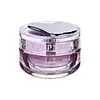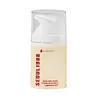What's inside
What's inside
 Key Ingredients
Key Ingredients

 Benefits
Benefits

 Concerns
Concerns

 Ingredients Side-by-side
Ingredients Side-by-side

Water
Skin ConditioningHydrogenated Polydecene
EmollientCaprylic/Capric Triglyceride
MaskingPropanediol
SolventDipropylene Glycol
HumectantGlycereth-26
HumectantGlycerin
Humectant1,2-Hexanediol
Skin ConditioningNiacinamide
SmoothingPolyglyceryl-3 Methylglucose Distearate
EmulsifyingGlyceryl Stearate
EmollientCetearyl Olivate
Sorbitan Olivate
EmulsifyingPEG-100 Stearate
Butylene Glycol
HumectantDimethicone
EmollientAcrylates/C10-30 Alkyl Acrylate Crosspolymer
Emulsion StabilisingParfum
MaskingTromethamine
BufferingHydroxyethyl Acrylate/Sodium Acryloyldimethyl Taurate Copolymer
Emulsion StabilisingSodium Polyacrylate
AbsorbentCetearyl Alcohol
EmollientSqualane
EmollientCentella Asiatica Extract
CleansingEthylhexylglycerin
Skin ConditioningXanthan Gum
EmulsifyingPortulaca Oleracea Extract
Skin ConditioningAdenosine
Skin ConditioningPolysorbate 60
EmulsifyingVitex Agnus-Castus Extract
AstringentChamomilla Recutita Flower Extract
MaskingSorbitan Isostearate
EmulsifyingPanthenol
Skin ConditioningArctium Lappa Root Extract
Skin ConditioningPhellinus Linteus Extract
Skin ConditioningPolyglyceryl-10 Laurate
Skin ConditioningGarcinia Cambogia Fruit Extract
Skin ConditioningCucurbita Pepo Seed Extract
Skin ConditioningPolyglyceryl-10 Stearate
Skin ConditioningHydrogenated Lecithin
EmulsifyingSodium Hyaluronate
HumectantTripeptide-1
Skin ConditioningHydrolyzed Collagen
EmollientArginine/Lysine Polypeptide
Skin ConditioningAcetyl Tetrapeptide-2
Skin ConditioningAcetyl Tetrapeptide-5
HumectantCopper Tripeptide-1
Skin ConditioningHexapeptide-11
Skin ConditioningHexapeptide-9
Skin ConditioningPalmitoyl Pentapeptide-4
Skin ConditioningPalmitoyl Tripeptide-1
Skin ConditioningPalmitoyl Tripeptide-5
Skin ConditioningGlutathione
Water, Hydrogenated Polydecene, Caprylic/Capric Triglyceride, Propanediol, Dipropylene Glycol, Glycereth-26, Glycerin, 1,2-Hexanediol, Niacinamide, Polyglyceryl-3 Methylglucose Distearate, Glyceryl Stearate, Cetearyl Olivate, Sorbitan Olivate, PEG-100 Stearate, Butylene Glycol, Dimethicone, Acrylates/C10-30 Alkyl Acrylate Crosspolymer, Parfum, Tromethamine, Hydroxyethyl Acrylate/Sodium Acryloyldimethyl Taurate Copolymer, Sodium Polyacrylate, Cetearyl Alcohol, Squalane, Centella Asiatica Extract, Ethylhexylglycerin, Xanthan Gum, Portulaca Oleracea Extract, Adenosine, Polysorbate 60, Vitex Agnus-Castus Extract, Chamomilla Recutita Flower Extract, Sorbitan Isostearate, Panthenol, Arctium Lappa Root Extract, Phellinus Linteus Extract, Polyglyceryl-10 Laurate, Garcinia Cambogia Fruit Extract, Cucurbita Pepo Seed Extract, Polyglyceryl-10 Stearate, Hydrogenated Lecithin, Sodium Hyaluronate, Tripeptide-1, Hydrolyzed Collagen, Arginine/Lysine Polypeptide, Acetyl Tetrapeptide-2, Acetyl Tetrapeptide-5, Copper Tripeptide-1, Hexapeptide-11, Hexapeptide-9, Palmitoyl Pentapeptide-4, Palmitoyl Tripeptide-1, Palmitoyl Tripeptide-5, Glutathione
Water
Skin ConditioningCetyl Ethylhexanoate
EmollientGlycerin
HumectantButylene Glycol
Humectant1,2-Hexanediol
Skin ConditioningNiacinamide
SmoothingPropanediol
SolventAmmonium Acryloyldimethyltaurate/Vp Copolymer
Carbomer
Emulsion StabilisingTromethamine
BufferingSodium Acrylate/Sodium Acryloyldimethyl Taurate Copolymer
Emulsion StabilisingPolyisobutene
Caprylic/Capric Triglyceride
MaskingLactobacillus
Skin ConditioningLactobacillus/Rice Ferment
Skin ConditioningLactobacillus/Soybean Ferment Extract
Skin ConditioningMacadamia Ternifolia Seed Oil
EmollientSaccharomyces/Coix Lacryma-Jobi Ma-Yuen Seed Ferment Filtrate
Skin ConditioningSaccharomyces/Potato Extract Ferment Filtrate
HumectantXanthan Gum
EmulsifyingHydrogenated Lecithin
EmulsifyingDisodium EDTA
Ethylhexylglycerin
Skin ConditioningAllantoin
Skin ConditioningCaprylyl Glycol
EmollientAdenosine
Skin ConditioningGlyceryl Acrylate/Acrylic Acid Copolymer
HumectantCaprylyl/Capryl Glucoside
CleansingCholesterol
EmollientPolyglyceryl-10 Oleate
Skin ConditioningSorbitan Oleate
EmulsifyingBrassica Campestris Sterols
EmollientPhytosteryl/Behenyl/Octyldodecyl Lauroyl Glutamate
Skin ConditioningRetinal
Skin ConditioningSilica
AbrasiveAluminum/Magnesium Hydroxide Stearate
Emulsion StabilisingTocopherol
AntioxidantPotassium Cetyl Phosphate
EmulsifyingPentaerythrityl Tetra-Di-T-Butyl Hydroxyhydrocinnamate
AntioxidantArctium Lappa Root Extract
Skin ConditioningCnidium Officinale Root Extract
Skin ConditioningDioscorea Japonica Root Extract
Skin ConditioningPaeonia Suffruticosa Root Extract
Skin ProtectingRehmannia Chinensis Root Extract
Skin Conditioning3-O-Ethyl Ascorbic Acid
Skin ConditioningBakuchiol
AntimicrobialSh-Oligopeptide-1
Skin ConditioningSh-Oligopeptide-2
Skin ConditioningSh-Polypeptide-1
Skin ConditioningWater, Cetyl Ethylhexanoate, Glycerin, Butylene Glycol, 1,2-Hexanediol, Niacinamide, Propanediol, Ammonium Acryloyldimethyltaurate/Vp Copolymer, Carbomer, Tromethamine, Sodium Acrylate/Sodium Acryloyldimethyl Taurate Copolymer, Polyisobutene, Caprylic/Capric Triglyceride, Lactobacillus, Lactobacillus/Rice Ferment, Lactobacillus/Soybean Ferment Extract, Macadamia Ternifolia Seed Oil, Saccharomyces/Coix Lacryma-Jobi Ma-Yuen Seed Ferment Filtrate, Saccharomyces/Potato Extract Ferment Filtrate, Xanthan Gum, Hydrogenated Lecithin, Disodium EDTA, Ethylhexylglycerin, Allantoin, Caprylyl Glycol, Adenosine, Glyceryl Acrylate/Acrylic Acid Copolymer, Caprylyl/Capryl Glucoside, Cholesterol, Polyglyceryl-10 Oleate, Sorbitan Oleate, Brassica Campestris Sterols, Phytosteryl/Behenyl/Octyldodecyl Lauroyl Glutamate, Retinal, Silica, Aluminum/Magnesium Hydroxide Stearate, Tocopherol, Potassium Cetyl Phosphate, Pentaerythrityl Tetra-Di-T-Butyl Hydroxyhydrocinnamate, Arctium Lappa Root Extract, Cnidium Officinale Root Extract, Dioscorea Japonica Root Extract, Paeonia Suffruticosa Root Extract, Rehmannia Chinensis Root Extract, 3-O-Ethyl Ascorbic Acid, Bakuchiol, Sh-Oligopeptide-1, Sh-Oligopeptide-2, Sh-Polypeptide-1
Ingredients Explained
These ingredients are found in both products.
Ingredients higher up in an ingredient list are typically present in a larger amount.
1,2-Hexanediol is a synthetic liquid and another multi-functional powerhouse.
It is a:
- Humectant, drawing moisture into the skin
- Emollient, helping to soften skin
- Solvent, dispersing and stabilizing formulas
- Preservative booster, enhancing the antimicrobial activity of other preservatives
Adenosine is in every living organism. It is one of four components in nucleic acids that helps store our DNA.
Adenosine has many benefits when used. These benefits include hydrating the skin, smoothing skin, and reducing wrinkles. Once applied, adenosine increases collagen production. It also helps with improving firmness and tissue repair.
Studies have found adenosine may also help with wound healing.
In skincare products, Adenosine is usually derived from yeast.
Learn more about AdenosineArctium Lappa Root Extract is from the burdock plant. It has antioxidant, anti-inflammatory, and anti-fungal properties.
Butylene Glycol (or BG) is used within cosmetic products for a few different reasons:
Overall, Butylene Glycol is a safe and well-rounded ingredient that works well with other ingredients.
Though this ingredient works well with most skin types, some people with sensitive skin may experience a reaction such as allergic rashes, closed comedones, or itchiness.
Learn more about Butylene GlycolThis ingredient is an emollient, solvent, and texture enhancer. It is considered a skin-softener by helping the skin prevent moisture loss.
It helps thicken a product's formula and makes it easier to spread by dissolving clumping compounds.
Caprylic Triglyceride is made by combining glycerin with coconut oil, forming a clear liquid.
While there is an assumption Caprylic Triglyceride can clog pores due to it being derived from coconut oil, there is no research supporting this.
Learn more about Caprylic/Capric TriglycerideEthylhexylglycerin (we can't pronounce this either) is commonly used as a preservative and skin softener. It is derived from glyceryl.
You might see Ethylhexylglycerin often paired with other preservatives such as phenoxyethanol. Ethylhexylglycerin has been found to increase the effectiveness of these other preservatives.
Glycerin is already naturally found in your skin. It helps moisturize and protect your skin.
A study from 2016 found glycerin to be more effective as a humectant than AHAs and hyaluronic acid.
As a humectant, it helps the skin stay hydrated by pulling moisture to your skin. The low molecular weight of glycerin allows it to pull moisture into the deeper layers of your skin.
Hydrated skin improves your skin barrier; Your skin barrier helps protect against irritants and bacteria.
Glycerin has also been found to have antimicrobial and antiviral properties. Due to these properties, glycerin is often used in wound and burn treatments.
In cosmetics, glycerin is usually derived from plants such as soybean or palm. However, it can also be sourced from animals, such as tallow or animal fat.
This ingredient is organic, colorless, odorless, and non-toxic.
Glycerin is the name for this ingredient in American English. British English uses Glycerol/Glycerine.
Learn more about GlycerinHydrogenated Lecithin is created from the hydrogenation of lecithin (a group of phospholipids). Hydrogenation is a chemical reaction between hydrogen and another element.
This ingredient is an emollient and emulsifier. As an emollient, it helps soften skin by trapping moisture within. As an emulsifier, it prevents oil and water ingredients from separating.
Niacinamide is a multitasking form of vitamin B3 that strengthens the skin barrier, reduces pores and dark spots, regulates oil, and improves signs of aging.
And the best part? It's gentle and well-tolerated by most skin types, including sensitive and reactive skin.
You might have heard of "niacin flush", or the reddening of skin that causes itchiness. Niacinamide has not been found to cause this.
In very rare cases, some individuals may not be able to tolerate niacinamide at all or experience an allergic reaction to it.
If you are experiencing flaking, irritation, and dryness with this ingredient, be sure to double check all your products as this ingredient can be found in all categories of skincare.
When incorporating niacinamide into your routine, look out for concentration amounts. Typically, 5% niacinamide provides benefits such as fading dark spots. However, if you have sensitive skin, it is better to begin with a smaller concentration.
When you apply niacinamide to your skin, your body converts it into nicotinamide adenine dinucleotide (NAD). NAD is an essential coenzyme that is already found in your cells as "fuel" and powers countless biological processes.
In your skin, NAD helps repair cell damage, produce new healthy cells, support collagen production, strengthen the skin barrier, and fight environmental stressors (like UV and pollution).
Our natural NAD levels start to decline with age, leading to slower skin repair, visible aging, and a weaker skin barrier. By providing your skin niacinamide, you're recharging your skin's NAD levels. This leads to stronger, healthier, and younger looking skin.
Another name for vitamin B3 is nicotinamide. This vitamin is water-soluble and our bodies don't store it. We obtain Vitamin B3 from either food or skincare. Meat, fish, wheat, yeast, and leafy greens contain vitamin B3.
The type of niacinamide used in skincare is synthetically created.
Learn more about NiacinamidePropanediol is an all-star ingredient. It softens, hydrates, and smooths the skin.
It’s often used to:
Propanediol is not likely to cause sensitivity and considered safe to use. It is derived from corn or petroleum with a clear color and no scent.
Learn more about PropanediolTromethamine helps balance the pH and improve the texture of a product. It is synthetically created.
As an emulsifier, Tromethamine prevents oil and water ingredients from separating. This helps stabilize the product and elongate a product's shelf life. Tromethamine also makes a product thicker.
Tromethamine helps balance the pH level of a product. Normal pH level of skin is slightly acidic (~4.75-5.5). The acidity of our skin is maintained by our glands and skin biome. Being slightly acidic allows our skin to create an "acid mantle". This acid mantle is a thin barrier that protects our skin from bacteria and contaminants.
Oral Tromethanmine is an anti-inflammatory drug but plays the role of masking, adding fragrance, and/or balancing pH in skincare.
1,3-Propanediol, 2-amino-2-(hydroxymethyl)-
Learn more about TromethamineWater. It's the most common cosmetic ingredient of all. You'll usually see it at the top of ingredient lists, meaning that it makes up the largest part of the product.
So why is it so popular? Water most often acts as a solvent - this means that it helps dissolve other ingredients into the formulation.
You'll also recognize water as that liquid we all need to stay alive. If you see this, drink a glass of water. Stay hydrated!
Learn more about WaterXanthan gum is used as a stabilizer and thickener within cosmetic products. It helps give products a sticky, thick feeling - preventing them from being too runny.
On the technical side of things, xanthan gum is a polysaccharide - a combination consisting of multiple sugar molecules bonded together.
Xanthan gum is a pretty common and great ingredient. It is a natural, non-toxic, non-irritating ingredient that is also commonly used in food products.
Learn more about Xanthan Gum